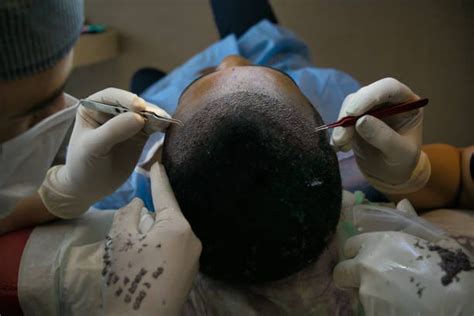Millions of Americans grapple with hair loss, a condition that can significantly impact their self-esteem and overall well-being. Whether due to genetics, medical treatments, or lifestyle factors, hair loss can be a source of frustration and anxiety. Fortunately, advancements in hair replacement techniques have revolutionized the options available to address this challenge. This comprehensive guide will delve into the seven most effective hair replacement options in Chicago, empowering you to make an informed decision on the best solution for your specific needs.

1. Surgical Hair Restoration (FUT)
Follicular Unit Transplantation (FUT), also known as the strip method, is a traditional surgical hair transplant procedure that involves removing a strip of skin from the donor area, typically the back of the scalp. This strip is then divided into individual follicular units, which are transplanted into the recipient area affected by hair loss. FUT is a highly effective technique that provides permanent results, but it can leave a visible scar in the donor area.
2. Surgical Hair Restoration (FUE)
Follicular Unit Extraction (FUE) is a more advanced surgical hair transplant technique that involves extracting individual follicular units directly from the donor area using a specialized tool. These follicular units are then transplanted into the recipient area, creating a more natural-looking result. FUE is less invasive than FUT and does not leave a visible scar in the donor area, making it a preferred option for many patients.
3. Non-Surgical Hair Replacement (Toppik)
Toppik is a non-surgical hair replacement solution that uses tiny, electrostatic fibres to create the appearance of thicker, fuller hair. These fibres are made of keratin, a protein naturally found in human hair, and they attach to existing hair fibres, blending in seamlessly. Toppik is a temporary solution that can be easily applied and removed with shampoo.
4. Non-Surgical Hair Replacement (Hairpieces)
Hairpieces are non-surgical hair replacement devices that come in a variety of styles and materials. They can be made from synthetic or human hair and are designed to cover areas of hair loss or thinning. Hairpieces can be attached using clips, glue, or tape, and they are a versatile solution that allows for customization to match individual needs.
5. Non-Surgical Hair Replacement (Hair Extensions)
Hair extensions are non-surgical hair replacement devices that are used to add length and volume to existing hair. They can be made from synthetic or human hair and are attached to the natural hair using various methods, such as clips, bonds, or tape. Hair extensions are a temporary solution that can be customized to create a wide range of styles.
6. Non-Surgical Hair Replacement (Scalp Micropigmentation)
Scalp micropigmentation is a non-surgical hair replacement technique that involves tattooing tiny dots of pigment into the scalp to create the illusion of hair follicles. This technique is particularly effective for people with thinning hair or areas of partial hair loss. Scalp micropigmentation is a permanent solution that can provide a natural-looking result.
7. Treating Underlying Medical Conditions
In some cases, hair loss may be a symptom of an underlying medical condition, such as thyroid disease, anemia, or alopecia areata. If you are experiencing hair loss, it is important to consult with a healthcare professional to rule out any underlying medical conditions and determine the best course of treatment.
The best hair replacement option for you will depend on your individual needs, preferences, and budget. Here are a few questions to consider when making your decision:
- What is the extent of your hair loss?
- What is your desired result?
- Are you willing to undergo surgery?
- What is your budget?
The cost of hair replacement in Chicago can vary depending on the procedure you choose, the number of grafts required, and the experience of the surgeon or technician. Here are some approximate costs for each procedure:
- Surgical Hair Restoration (FUT): $4,000 – $15,000
- Surgical Hair Restoration (FUE): $5,000 – $20,000
- Non-Surgical Hair Replacement (Toppik): $20 – $60 per month
- Non-Surgical Hair Replacement (Hairpieces): $500 – $3,000
- Non-Surgical Hair Replacement (Hair Extensions): $200 – $1,000 per set
- Non-Surgical Hair Replacement (Scalp Micropigmentation): $1,000 – $3,000 per session
Hair replacement can provide numerous benefits, including:
- Improved self-confidence
- Enhanced appearance
- Reduced anxiety and stress
- Increased social interaction
- Improved quality of life
Hair replacement has evolved tremendously, offering a wide range of effective solutions to address hair loss. By understanding the different options available and carefully considering your individual needs, you can find the best hair replacement solution to restore your confidence and enhance your overall well-being.
